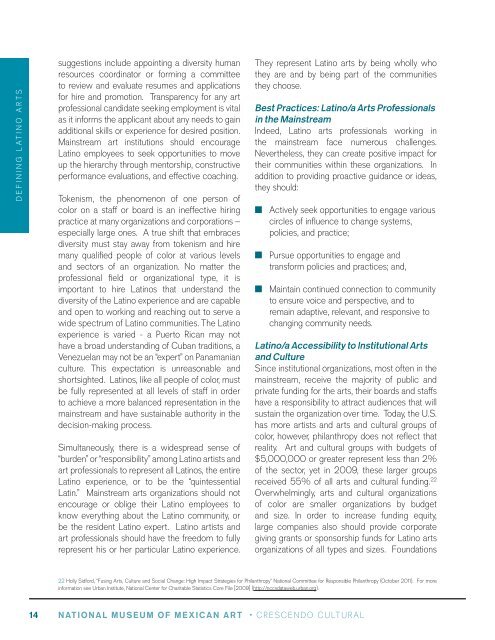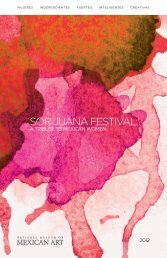Crescendo Cultural
Crescendo Cultural - National Museum of Mexican Art
Crescendo Cultural - National Museum of Mexican Art
- No tags were found...
Create successful ePaper yourself
Turn your PDF publications into a flip-book with our unique Google optimized e-Paper software.
D tAb e F ininG L e oF LAtino Contents A rtssuggestions include appointing a diversity humanresources coordinator or forming a committeeto review and evaluate resumes and applicationsfor hire and promotion. transparency for any artprofessional candidate seeking employment is vitalas it informs the applicant about any needs to gainadditional skills or experience for desired position.Mainstream art institutions should encourageLatino employees to seek opportunities to moveup the hierarchy through mentorship, constructiveperformance evaluations, and effective coaching.tokenism, the phenomenon of one person ofcolor on a staff or board is an ineffective hiringpractice at many organizations and corporations –especially large ones. A true shift that embracesdiversity must stay away from tokenism and hiremany qualified people of color at various levelsand sectors of an organization. no matter theprofessional field or organizational type, it isimportant to hire Latinos that understand thediversity of the Latino experience and are capableand open to working and reaching out to serve awide spectrum of Latino communities. the Latinoexperience is varied - a Puerto rican may nothave a broad understanding of Cuban traditions, aVenezuelan may not be an “expert” on Panamanianculture. this expectation is unreasonable andshortsighted. Latinos, like all people of color, mustbe fully represented at all levels of staff in orderto achieve a more balanced representation in themainstream and have sustainable authority in thedecision-making process.simultaneously, there is a widespread sense of“burden” or “responsibility” among Latino artists andart professionals to represent all Latinos, the entireLatino experience, or to be the “quintessentialLatin.” Mainstream arts organizations should notencourage or oblige their Latino employees toknow everything about the Latino community, orbe the resident Latino expert. Latino artists andart professionals should have the freedom to fullyrepresent his or her particular Latino experience.they represent Latino arts by being wholly whothey are and by being part of the communitiesthey choose.Best Practices: Latino/a Arts Professionalsin the Mainstreamindeed, Latino arts professionals working inthe mainstream face numerous challenges.nevertheless, they can create positive impact fortheir communities within these organizations. inaddition to providing proactive guidance or ideas,they should:n Actively seek opportunities to engage variouscircles of influence to change systems,policies, and practice;n Pursue opportunities to engage andtransform policies and practices; and,n Maintain continued connection to communityto ensure voice and perspective, and toremain adaptive, relevant, and responsive tochanging community needs.Latino/a Accessibility to Institutional Artsand Culturesince institutional organizations, most often in themainstream, receive the majority of public andprivate funding for the arts, their boards and staffshave a responsibility to attract audiences that willsustain the organization over time. today, the U.s.has more artists and arts and cultural groups ofcolor, however, philanthropy does not reflect thatreality. Art and cultural groups with budgets of$5,000,000 or greater represent less than 2%of the sector, yet in 2009, these larger groupsreceived 55% of all arts and cultural funding. 22overwhelmingly, arts and cultural organizationsof color are smaller organizations by budgetand size. in order to increase funding equity,large companies also should provide corporategiving grants or sponsorship funds for Latino artsorganizations of all types and sizes. Foundations22 Holly sidford, “Fusing Arts, Culture and social Change: High impact strategies for Philanthropy” national Committee for responsible Philanthropy (october 2011). For moreinformation see Urban institute, national Center for Charitable statistics Core File [2009] (http://nccsdataweb.urban.org).and corporate giving programs are part of apublic investment, which should include a diverseapproach to the arts.Latinos are significantly underrepresentedin mainstream visitorship and audiences. 23Admission fees for most arts organizations makeattendance or participation challenging for awide array of communities. information aboutdiscounted fees, free days, or special programs isoften not widely or effectively disseminated to thetarget community. Without access, many Latinosdo not reap the benefits of the arts and are lesslikely to become its champions. 24 Designingprograms and initiatives that are focused on“demand-side” decision-making will ensurethat individuals attend the arts experience theyvalue the most. Art organizations should provideopportunities for individuals and families to attendtheir institutions and participate in their programsby seeking resources to help facilitate greateraccessibility. 25 Philanthropy has the opportunityto play a significant role to increase access tothese institutions and to ensure an interest or“demand” for specific types of arts and culturalprogramming. Funders that put the responsibilityfor building demand and providing accessibility onarts organizations will lead to increased attentionto audience development and service to broadercommunities’ interests and needs.the question of accessibility naturally informsthe perceived public value and whether arts areseen as a luxury or as dispensable. Creating astrong message about the impact of arts andculture articulates more persuasively the value ofart within the Latino community. impact highlightsinclude: increased knowledge of sequencing,motor dexterity, and 21 st century technologicalskills and improved literacy, discipline and selfesteem.it is important to include these highlightsand provide examples as part of the messagingLatino arts organizations employ for its advocacy,fundraising and communication efforts.Increasing Inclusivity of Latinos in theMainstreamthe issue of inclusivity is also of supreme importanceas is Latino accessibility to the arts. if Latino artistsare excluded from mainstream institutions directlyor indirectly, not only will their voices and works bedenied to large audiences, but also discriminatoryand inaccurate productions may result.Playwright stephen Adly Guirgis publicallydiscussed his disapproval of non-Latino actors inthe role of Puerto rican characters in a productionof his play “the ______________ With the Hat”at theaterWorks in Hartford, Connecticut. Heexpressed his great displeasure in Artsbeat: “What ido care about – deeply – is that i wrote a play wherethe two leads are clearly Latino, and Latino actorswere completely shut out of the casting process forthose two roles.” 26 He discussed how theaters wishto broaden their audiences and then some makedecisions that are “non-inclusive”. 27 this is not thefirst or last time a theater director or producer willcast white actors for Latino roles without hostingan open casting call. still today, Latinos are shutout of roles designed for them. theaters, like otherarts organizations, should not subject audiences tothe “time warp” that Guirgis felt when he saw thisproduction without Latino actor representation in acity with a 40 percent Latino population.the recent staging of a more modern Cubanrenderingproduction of Much Ado Aboutnothing at the shakespeare theatre Company inWashington D.C. provides an example of Latinomisrepresentation in the arts. some consideredthe changing of two minor characters to “JuanHuevos” and “Jose Frijoles” as demeaning andstereotypical. 28 Further the accuracy of Cubancultural references infused in the play was called23 Center for the Future of Museums (AAM) has recorded a decline in minority visitorship to museums: http://culturalpolicy.uchicago.edu/publications/Demographic-transformation.pdf24 Arts educators should engage in an on-the-ground approach: engage with public schools, children’s hospitals, street fairs, community festivals, and other communityvenues. 25 Cool Culture in new York City serves as and intermediary for low incomes parents and children, especially in Head start, with cultural organizations. through itsprogramming, free admission to 90 cultural institutions is provided to about 50,000 families at a value of 1.5 million dollars. 26 stephen Adly Guirgis, “theater talkback: Diminishingthe ‘Hat’? About that Casting Controversy” the new York times: Artsbeat (December 9, 2011). 27 id. 28 Peter Marks, “shakespeare theatre’s ‘Mucho Ado’ raises questionof Latino stereotypes” the Washington Post, (December 19, 2011).14 NATIONAL MUSEUM OF MEXICAN ART • CresCenDo CULtUrAL NATIONAL MUSEUM OF MEXICAN ART • CresCenDo CULtUrAL 15



